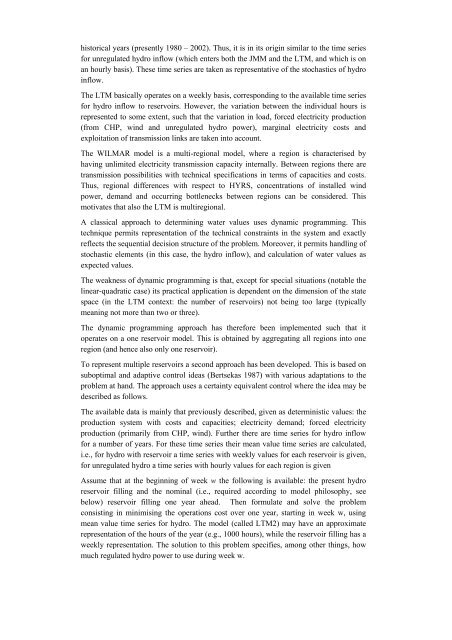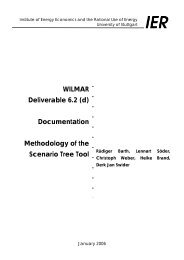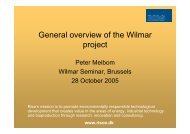Final Technical Report - WILMAR Wind Power Integration in ...
Final Technical Report - WILMAR Wind Power Integration in ...
Final Technical Report - WILMAR Wind Power Integration in ...
You also want an ePaper? Increase the reach of your titles
YUMPU automatically turns print PDFs into web optimized ePapers that Google loves.
historical years (presently 1980 – 2002). Thus, it is <strong>in</strong> its orig<strong>in</strong> similar to the time series<br />
for unregulated hydro <strong>in</strong>flow (which enters both the JMM and the LTM, and which is on<br />
an hourly basis). These time series are taken as representative of the stochastics of hydro<br />
<strong>in</strong>flow.<br />
The LTM basically operates on a weekly basis, correspond<strong>in</strong>g to the available time series<br />
for hydro <strong>in</strong>flow to reservoirs. However, the variation between the <strong>in</strong>dividual hours is<br />
represented to some extent, such that the variation <strong>in</strong> load, forced electricity production<br />
(from CHP, w<strong>in</strong>d and unregulated hydro power), marg<strong>in</strong>al electricity costs and<br />
exploitation of transmission l<strong>in</strong>ks are taken <strong>in</strong>to account.<br />
The <strong>WILMAR</strong> model is a multi-regional model, where a region is characterised by<br />
hav<strong>in</strong>g unlimited electricity transmission capacity <strong>in</strong>ternally. Between regions there are<br />
transmission possibilities with technical specifications <strong>in</strong> terms of capacities and costs.<br />
Thus, regional differences with respect to HYRS, concentrations of <strong>in</strong>stalled w<strong>in</strong>d<br />
power, demand and occurr<strong>in</strong>g bottlenecks between regions can be considered. This<br />
motivates that also the LTM is multiregional.<br />
A classical approach to determ<strong>in</strong><strong>in</strong>g water values uses dynamic programm<strong>in</strong>g. This<br />
technique permits representation of the technical constra<strong>in</strong>ts <strong>in</strong> the system and exactly<br />
reflects the sequential decision structure of the problem. Moreover, it permits handl<strong>in</strong>g of<br />
stochastic elements (<strong>in</strong> this case, the hydro <strong>in</strong>flow), and calculation of water values as<br />
expected values.<br />
The weakness of dynamic programm<strong>in</strong>g is that, except for special situations (notable the<br />
l<strong>in</strong>ear-quadratic case) its practical application is dependent on the dimension of the state<br />
space (<strong>in</strong> the LTM context: the number of reservoirs) not be<strong>in</strong>g too large (typically<br />
mean<strong>in</strong>g not more than two or three).<br />
The dynamic programm<strong>in</strong>g approach has therefore been implemented such that it<br />
operates on a one reservoir model. This is obta<strong>in</strong>ed by aggregat<strong>in</strong>g all regions <strong>in</strong>to one<br />
region (and hence also only one reservoir).<br />
To represent multiple reservoirs a second approach has been developed. This is based on<br />
suboptimal and adaptive control ideas (Bertsekas 1987) with various adaptations to the<br />
problem at hand. The approach uses a certa<strong>in</strong>ty equivalent control where the idea may be<br />
described as follows.<br />
The available data is ma<strong>in</strong>ly that previously described, given as determ<strong>in</strong>istic values: the<br />
production system with costs and capacities; electricity demand; forced electricity<br />
production (primarily from CHP, w<strong>in</strong>d). Further there are time series for hydro <strong>in</strong>flow<br />
for a number of years. For these time series their mean value time series are calculated,<br />
i.e., for hydro with reservoir a time series with weekly values for each reservoir is given,<br />
for unregulated hydro a time series with hourly values for each region is given<br />
Assume that at the beg<strong>in</strong>n<strong>in</strong>g of week w the follow<strong>in</strong>g is available: the present hydro<br />
reservoir fill<strong>in</strong>g and the nom<strong>in</strong>al (i.e., required accord<strong>in</strong>g to model philosophy, see<br />
below) reservoir fill<strong>in</strong>g one year ahead. Then formulate and solve the problem<br />
consist<strong>in</strong>g <strong>in</strong> m<strong>in</strong>imis<strong>in</strong>g the operations cost over one year, start<strong>in</strong>g <strong>in</strong> week w, us<strong>in</strong>g<br />
mean value time series for hydro. The model (called LTM2) may have an approximate<br />
representation of the hours of the year (e.g., 1000 hours), while the reservoir fill<strong>in</strong>g has a<br />
weekly representation. The solution to this problem specifies, among other th<strong>in</strong>gs, how<br />
much regulated hydro power to use dur<strong>in</strong>g week w.




